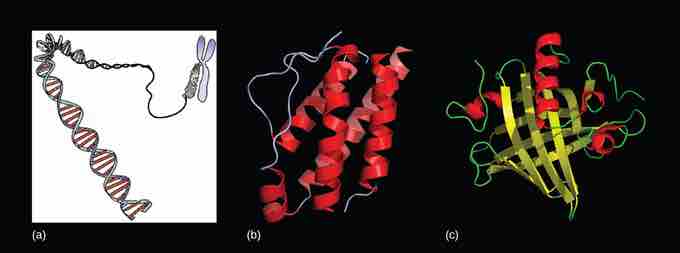Genes and Proteins
Since the rediscovery of Mendel's work in 1900, the definition of the gene has progressed from an abstract unit of heredity to a tangible molecular entity capable of replication, transcription, translation, and mutation. Genes are composed of DNA and are linearly arranged on chromosomes. Some genes encode structural and regulatory RNAs. There is increasing evidence from research that profiles the transcriptome of cells (the complete set all RNA transcripts present in a cell) that these may be the largest classes of RNAs produced by eukaryotic cells, far outnumbering the protein-encoding messenger RNAs (mRNAs), but the 20,000 protein-encoding genes typically found in animal cells, and the 30,o00 protein-encoding genes typically found in plant cells, nonetheless have huge impacts on cellular functioning.
Protein-encoding genes specify the sequences of amino acids, which are the building blocks of proteins . In turn, proteins are responsible for orchestrating nearly every function of the cell. Both protein-encoding genes and the proteins that are their gene products are absolutely essential to life as we know it.

Genes Encode Proteins
Genes, which are carried on (a) chromosomes, are linearly-organized instructions for making the RNA and protein molecules that are necessary for all of processes of life. The (b) interleukin-2 protein and (c) alpha-2u-globulin protein are just two examples of the array of different molecular structures that are encoded by genes.
Replication, Transcription, and Translation are the three main processes used by all cells to maintain their genetic information and to convert the genetic information encoded in DNA into gene products, which are either RNAs or proteins, depending on the gene. In eukaryotic cells, or those cells that have a nucleus, replication and transcription take place within the nucleus while translation takes place outside of the nucleus in cytoplasm. In prokaryotic cells, or those cells that do not have a nucleus, all three processes occur in the cytoplasm.
Replication is the basis for biological inheritance. It copies a cell's DNA. The enzyme DNA polymerase copies a single parental double-stranded DNA molecule into two daughter double-stranded DNA molecules. Transcription makes RNA from DNA. The enzyme RNA polymerase creates an RNA molecule that is complementary to a gene-encoding stretch of DNA. Translation makes protein from mRNA. The ribosome generates a polypeptide chain of amino acids using mRNA as a template. The polypeptide chain folds up to become a protein.